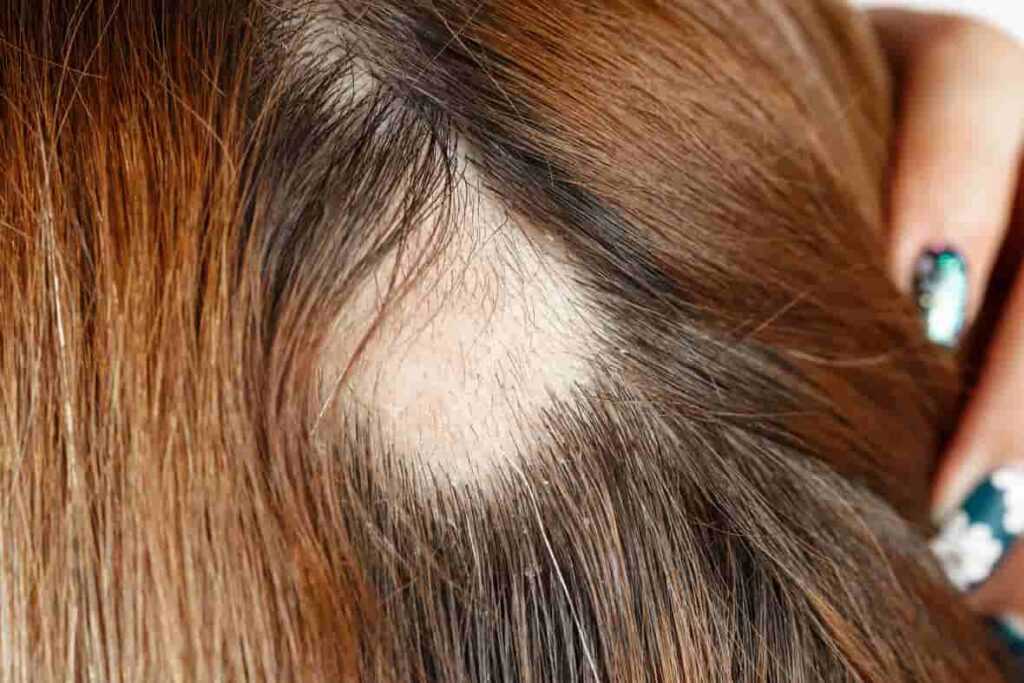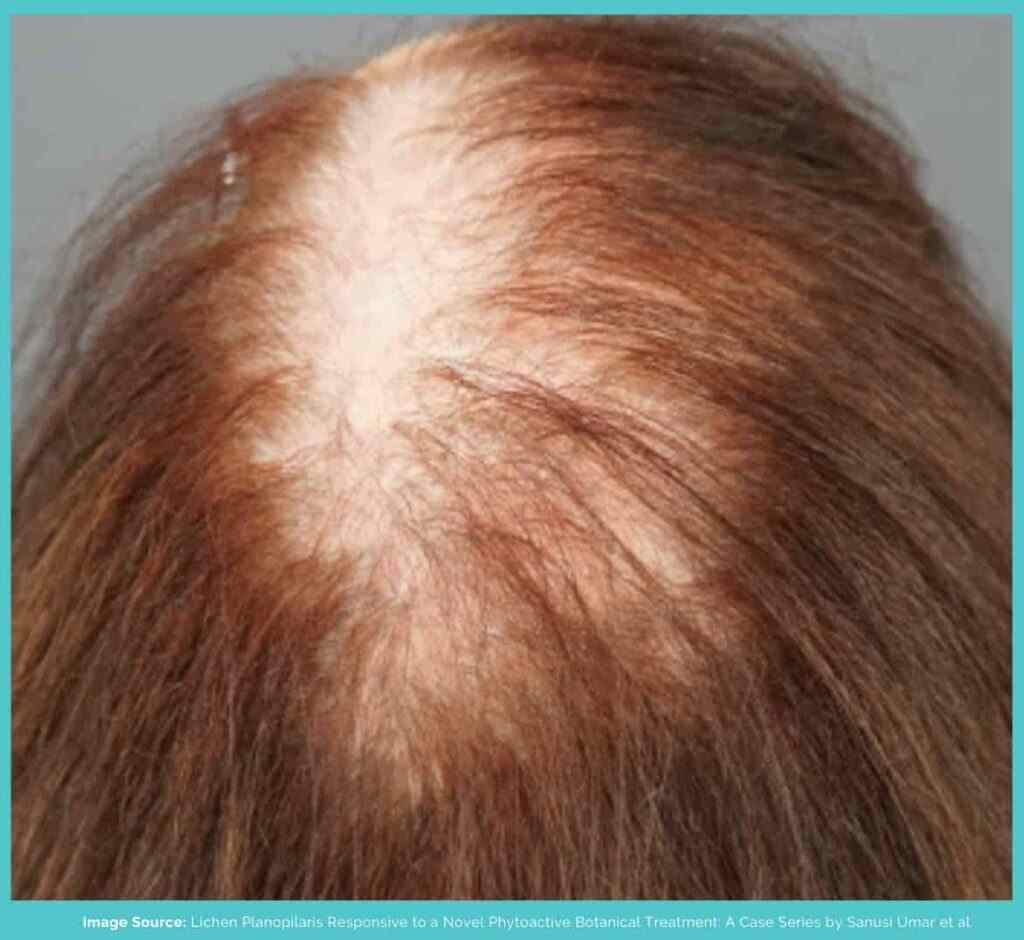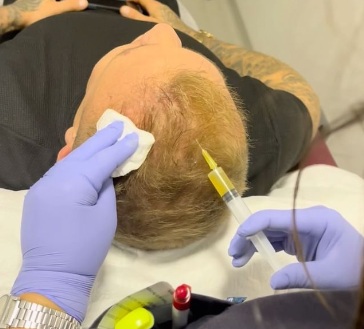Scarring or cicatricial alopecia is an umbrella term for a group of hair disorders that cause permanent destruction of hair follicles.
The result is irreversible permanent hair loss. This is unlike the far more common non-scarring alopecias in which the hair follicles are preserved, and the hair loss is reversed.
With scarring alopecia, it’s not even possible to predict how severe the hair loss will be. And above that, the exact cause of this condition is not exactly understood.
Still, there are some treatments that have been used for the management of this type of hair loss. They can be helpful, especially since this condition can be quite toll-taking physically and mentally. To learn more about it, read all the way to the end.
What Is Scarring Alopecia?
Scarring alopecia occurs when the hair follicles are destroyed directly by inflammation or indirectly by an internal or external factor.
In any case, it’s characterised by the destruction of hair follicles, which are then replaced by scar tissue.
There are no scars visible on the scalp, but the absence of hair follicles is evident by the lack of small pinpoint openings in the skin called follicular ostia.
Usually, hair loss takes place slowly over the years (however, it can also occur rapidly) until it reaches the end-stage burnout.
Once this happens, the inflammation clears up, and the bald spot doesn’t grow in size anymore. Unfortunately, at this stage, treatments for hair loss are likely to be less effective.

While it mainly affects the scalp, keep in mind that cicatricial alopecia can also cause hair loss on the face and body.
However, it isn’t contagious. And it’s not that common either, as only 3-7% of people have this type of hair loss. Most of them are adults, but it can also affect children and adolescents.
What Causes Scarring Alopecia?
It’s not exactly understood what causes scarring alopecia, but depending on how the hair follicle is destroyed, it has two types:
- Primary cicatricial alopecia
- Secondary cicatricial alopecia
Primary Cicatricial Alopecia
In primary cicatricial alopecia, the “bulge” of the hair follicle is directly targeted through an inflammatory process. It ends up damaging the hair follicle stem cells, without which the hair growth cycle cannot be sustained.
Depending on the types of inflammatory cells that cause primary cicatricial alopecia, it is further divided into lymphocytic, neutrophilic, and mixed infiltrates types.
Both lymphocytes and neutrophils are types of white blood cells that help the body’s immune system.
However, both these cells can also be involved in the inflammation of the hair follicles, resulting in primary cicatricial alopecias.
For instance, scarring alopecias that mainly involve lymphocytes include:
- Lichen planopilars (and its variant frontal fibrosing alopecia)
- Central centrifugal cicatricial alopecia
- Pseudopedale of Brocq
- Chronic cutaneous lupus erythematosus
- Graham-Little syndrome
There are others as well. But when it comes to neutrophilic inflammation, the following cicatricial alopecias are included:
- Folliculitis decalvans
- Dissecting cellulitis of the scalp
It could also be a mixture of inflammatory cells. And when that’s the case, it could be a case of acne keloidalis, acne necrotic or erosive pustulosis.
Most of the scarring alopecias are primary (lichen planopilaris being the most common), affecting more women than men.
Secondary Cicatricial Alopecia
Secondary cicatricial alopecia is when the hair follicle is destroyed as a result of something else. It’s not the direct target. It’s just collateral damage.
This can happen as a result of traumatic injury, burns, radiation, metastatic cancer, or an underlying illness. Even here, the hair loss is irreversible.
What Does Scarring Alopecia Look Like?
Scarring alopecia will result in the formation of bald patches on the scalp. While scar tissue replaces hair follicles, in most cases, there’s no visible scarring on the scalp. Instead, the bald patch (or patches) will appear smooth and shiny.

It can also be accompanied by other symptoms, such as:
- Itchiness
- Pain
- Burning sensation
- Redness
- Pustules
- Blisters
- Scaly skin
- Changes in skin pigmentation
They can vary depending on the type of hair loss you’re experiencing. Even between individuals, the progression can be different.
How Do You Know If You Have Scarring Alopecia?
You can look out for the signs and symptoms of scarring alopecia on your own. However, for an accurate diagnosis, a skin biopsy is usually needed.
For this, a small sample of your skin (2-4mm) will be removed for lab testing. Your doctor will give you local anaesthesia before cutting the skin so you don’t feel pain.
Is Scarring Alopecia Permanent?
Scarring alopecia doesn’t preserve the hair follicle or the stem cells in it. Therefore, the hair loss resulting from it is permanent and irreversible.
Keep in mind that hair follicle neogenesis (regeneration) is not something that happens in adults (although wound–induced hair neogenesis has been noted to occur). You cannot expect new hair follicles to grow after they’ve been destroyed.
Can Scarring Alopecia Be Cured?
Unfortunately, there’s no cure for scarring alopecia. However, while it can’t be reversed, there are treatments that can help control it.
It’s important to seek early treatment to save as much of your hair as possible. Otherwise, scarring alopecia can even leave you almost completely bald.
How To Stop Scarring Alopecia?
The treatment for scarring alopecia usually includes anti-inflammatory medications, steroids, and antibiotics. The treatment plan will depend on the type of scarring alopecia you have (depending on the inflammatory cells).
For instance, for lymphocytes, some of the following medications have been used:
- Hydroxychloroquine (antimalarial)
- Corticosteroids
- Cyclosporine (immunosuppressant)
- Retinoid
- Methotrexate (antimetabolite)
- Mycophenolate mofetil (immunosuppressants)
For neutrophilic cicatricial alopecia, antibiotics like clindamycin and doxycycline, isotretinoin, corticosteroids, and sulfone like dapsone might be used for treatment.
To promote hair growth in scarring alopecia, your doctor may also recommend the use of minoxidil and finasteride.
These treatments can control and maybe even undo some of the damage caused by scarring alopecia. You may even get satisfactory results with early treatment. But if the hair loss has progressed significantly, it might not get much better.
In that case, you can consider camouflage with wigs, hair fibres, makeup or even scalp micropigmentation.
Here, you should also note that in certain scarring alopecias, even bad hair practices (like tight hairstyles, chemical relaxers, and dyes) are implicated. So, you should consider changing your hair styling routine. And make sure to keep your scalp protected with sunscreen and other hair accessories.
Can You Get A Hair Transplant With Scarring Alopecia?
You may be able to get a hair transplant with scarring alopecia. However, you need to wait until your condition has stabilised for at least 2 years.
Even then, the surgery might not be a complete success since fewer hair grafts might survive. You may also be at increased risk of scarring.
Also, note that a hair transplant is only possible if you have sufficient “donor hair” on your scalp. If that’s not the case, you won’t be able to have this surgery.
Does PRP Work For Scarring Alopecia?
Platelet-rich plasma (PRP) injections can help reduce inflammation caused by scarring alopecia. A few studies have shown that PRP can stop certain types of cicatricial alopecia and even thicken hair. It can also help in the management of scars.

Therefore, you can consider getting these injections. However, you shouldn’t expect them to make a dramatic difference.
Conclusion
Scarring alopecia can cause extreme distress since they’re permanent and irreversible. Their exact cause is not known, and there’s no cure for them either.
Still, it’s possible to control this type of hair loss with different treatments. There’s no standard approach to treatment, but there’s been different research on what might work better.
If you’ve also noticed increasing hair loss, it’s a good idea to get in touch with a medical professional to start early treatment.
Reviewed and Approved by Trichologist Yaprak Yazan
FAQ
Is androgenetic alopecia scarring?
Androgenetic alopecia or pattern baldness is a type of non-cicatricial alopecia, and it’s the most common one.
Is scarring alopecia hereditary?
Scarring alopecia is not considered hereditary. However, in some of its forms, genetic factors have been implicated.
Is alopecia areata scarring?
Alopecia areata is another type of non-scarring alopecia. But even though it’s non-scarring, it can still cause permanent hair loss.
Does scarring alopecia spread?
Scarring alopecia can spread beyond the original site of occurrence. Different bald patches can even join together to form a bigger one.


